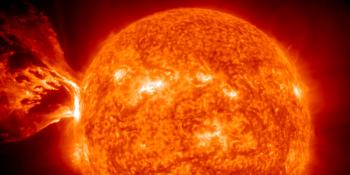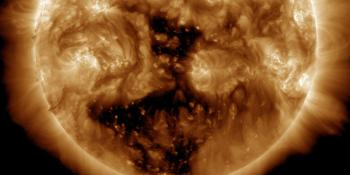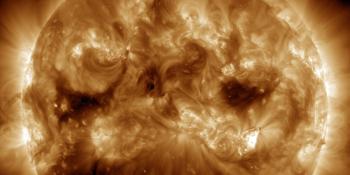Viewing archive of Monday, 26 February 2024
Solar activity report
Report of Solar-Geophysical Activity 2024 Feb 26 2200 UTCPrepared by the NOAA © SWPC and processed by SpaceWeatherLive.com
Joint USAF/NOAA Report of Solar and Geophysical Activity
SDF Number 57 Issued at 2200Z on 26 Feb 2024IA. Analysis of Solar Active Regions and Activity from 25-2100Z to 26-2100Z
Solar activity has been at very low levels for the past 24
hours. There are currently 7 numbered sunspot regions on the disk.
IB. Solar Activity Forecast
Solar activity is expected to be low with
a chance for M-class flares and a slight chance for an X-class flare on
days one, two, and three (27 Feb, 28 Feb, 29 Feb).
IIA. Geophysical Activity Summary 25-2100Z to 26-2100Z
The geomagnetic
field has been at quiet to unsettled levels for the past 24 hours. Solar
wind speed reached a peak of 450 km/s at 26/1624Z. Total IMF reached 12
nT at 25/2337Z. The maximum southward component of Bz reached -9 nT at
26/0008Z. Electrons greater than 2 MeV at geosynchronous orbit reached
a peak level of 129 pfu.
IIB. Geophysical Activity Forecast
The geomagnetic field is expected
to be at quiet to unsettled levels on day one (27 Feb) and quiet levels
on days two and three (28 Feb, 29 Feb). Protons have a slight chance of
crossing threshold on days one, two, and three (27 Feb, 28 Feb, 29 Feb).
III. Event Probabilities 27 Feb to 29 Feb
| Class M | 50% | 50% | 50% |
| Class X | 10% | 10% | 10% |
| Proton | 10% | 10% | 10% |
| PCAF | green | ||
IV. Penticton 10.7 cm Flux
Observed 26 Feb 172 Predicted 27 Feb-29 Feb 170/170/175 90 Day Mean 26 Feb 162
V. Geomagnetic A Indices
Observed Afr/Ap 25 Feb 014/010 Estimated Afr/Ap 26 Feb 011/012 Predicted Afr/Ap 27 Feb-29 Feb 009/008-006/005-006/005
VI. Geomagnetic Activity Probabilities 27 Feb to 29 Feb
| A. Middle Latitudes | |||
|---|---|---|---|
| Active | 10% | 10% | 10% |
| Minor storm | 01% | 01% | 01% |
| Major-severe storm | 01% | 01% | 01% |
| B. High Latitudes | |||
|---|---|---|---|
| Active | 15% | 15% | 15% |
| Minor storm | 25% | 20% | 15% |
| Major-severe storm | 20% | 20% | 10% |
All times in UTC
Latest news
Latest forum messages
More topicsSupport SpaceWeatherLive.com!
A lot of people come to SpaceWeatherLive to follow the Sun's activity or if there is aurora to be seen, but with more traffic comes higher server costs. Consider a donation if you enjoy SpaceWeatherLive so we can keep the website online!

Space weather facts
| Last X-flare | 2025/03/28 | X1.1 |
| Last M-flare | 2025/03/30 | M1.5 |
| Last geomagnetic storm | 2025/03/27 | Kp5 (G1) |
| Spotless days | |
|---|---|
| Last spotless day | 2022/06/08 |
| Monthly mean Sunspot Number | |
|---|---|
| February 2025 | 154.6 +17.6 |
| March 2025 | 127.5 -27.1 |
| Last 30 days | 127.5 -24.7 |


